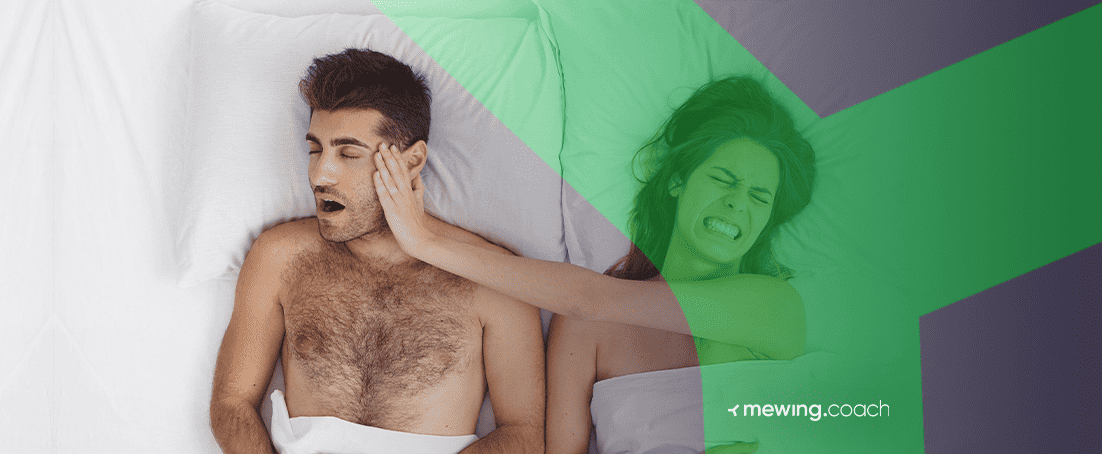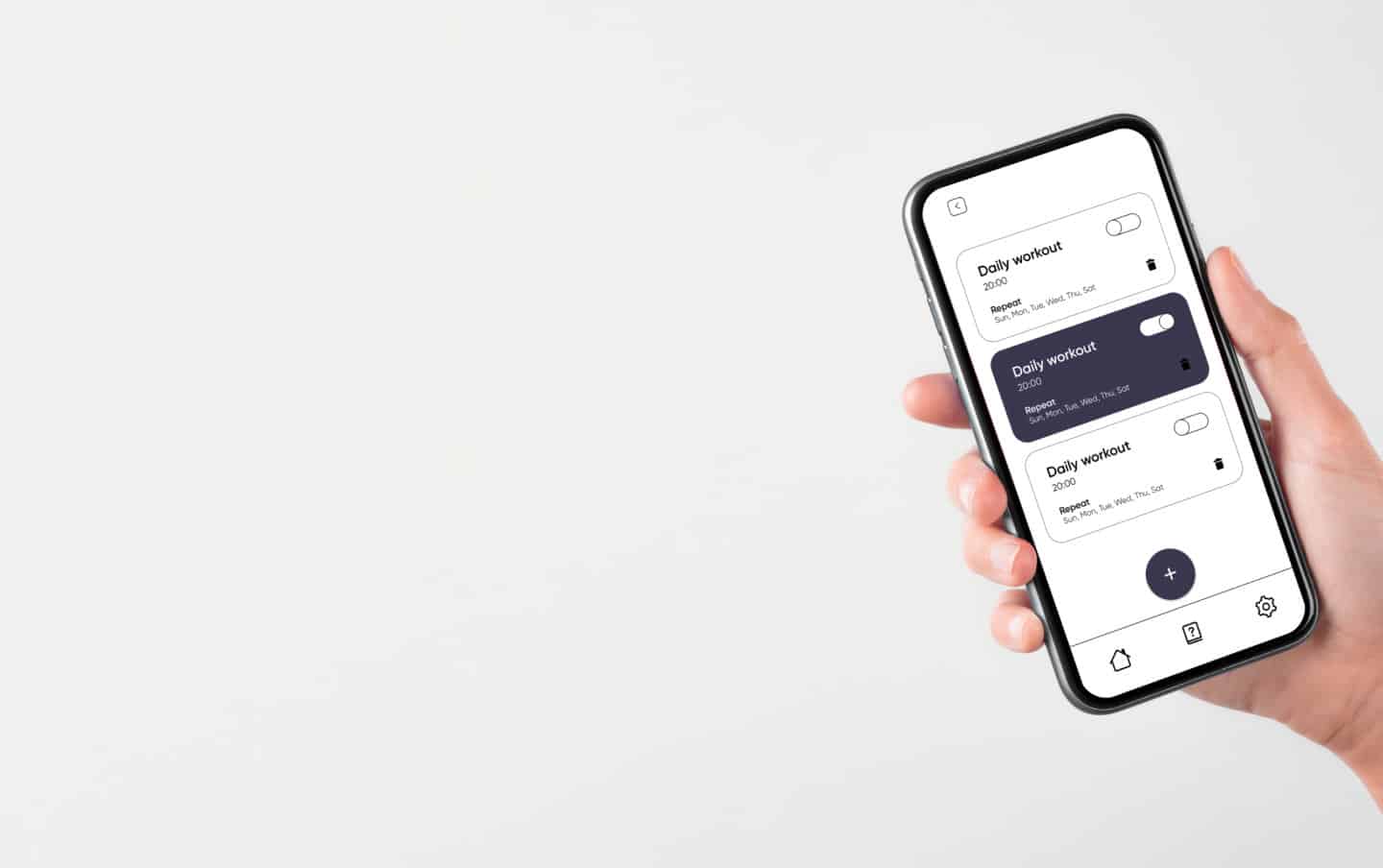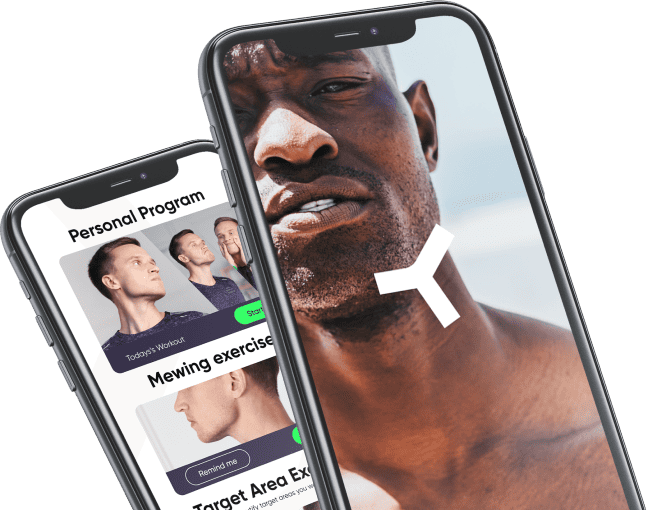Do you often wake yourself up with your own loud snoring in the middle of the night? Other treatments and even putting mouth tape on didn’t quite do the trick?
Don’t quit just yet! It’s high time you considered trying the mewing method. Doctor John Mew and his son Mike Mew have discovered a single treatment that fixes tongue and jaw posture, regulates the way we breathe, and also – helps with sleep apnea!
If you’re willing to practice regular mewing, sleep apnea will no longer be an issue that deprives you of well-needed rest.
Numerous mewing studies have proved that fixing sleep apnea is among the many things mewing can help with.
In this article, you’ll find more details on:
- ❓ How mewing can fix sleep apnea
- 💤 How a proper or improper tongue posture can reflect on your mouth breathing, nasal breathing, and sleep apnea
- ✅ A guide on reducing snoring accompanied with exercises and tips on breathing properly
So, if you’re in for a more relaxed night’s sleep, keep scrolling!

What Is Sleep Apnea
Sleep apnea is a sleeping disorder that disrupts the flow of oxygen to the brain and body, further implying serious health conditions risks, such as hypertension, strokes, cardiomyopathy (increased and enlargened heart muscle tissue) and heart attack.
When suffering from sleep apnea, the person’s breathing is heavily interrupted during the time they are supposed to be soundly asleep.
In many cases, people aren’t even aware that they’re dealing with an obstructed airway. Many individuals go about their day feeling confused when they feel fatigued even after a full night of sleep.
Obstructive Sleep Apnea
Obstructive sleep apnea is the most common sleep apnea type. It is usually caused by a collapse of the soft tissue in the back of the throat while asleep.
This causes airway blockages and forces your internal organs to work with more effort to achieve what is achieved normally while you’re awake. At the same time, these episodes prevent the flow of proper oxygen amount to your body.
Central Sleep Apnea
Central sleep apnea is a lot different from obstructive sleep apnea. It occurs because your brain fails to signalize and command your respiratory system properly.
Thus, this type of sleep apnea is common for people who have survived a stroke or have neuromuscular diseases or central nervous system dysfunctions, such as amyotrophic lateral sclerosis or even heart failure.
Complex Sleep Apnea Syndrome
The very name suggests that this type of sleep apnea is the most difficult. It’s the combination of both central and obstructive sleep apnea and usually requires medical treatment instead of exercise.
However, that’s not to say that you cannot improve it through exercises – but more on that below!
Sleep Apnea Causes
As we already explained, there is a huge correlation between sleep apnea and specific neuromuscular and other medical diseases, including a family history of diseases.
However, there are also other common causes that may lead to obstructive sleep apnea:
- Uneven heart rate/Nocturnal Cardiac Arrhythmia. Bradycardic arrhythmia and uneven heart rate while asleep is probably the greatest cause of obstructive and central sleep apnea.
- Heart failure. Naturally, heart failure and surgeries can result in sleep apnea because of the damaged heart muscle tissue, as well as the lack of oxygen to the blood while in surgery.
- Neuromuscular diseases. People suffering from Lou Gehrig’s disease or amyotrophic lateral sclerosis have a higher tendency to develop sleep apnea.
- Stroke. The stroke-sleep apnea relation is both ways. Strokes can be the cause of sleep apnea, but also, sleep apnea can lead to a stroke because of the continuous lack of oxygen in the blood.
- Kidney failure. People who suffer from chronic kidney diseases have a significantly increased chance of suffering from OSA and central sleep apnea. As opposed to the general population, patients with chronic kidney disease are the most likely to develop OSA and central sleep apnea. To add to this, sleep apnea in this demographic group has been associated with an increased risk of cardiovascular complications and mortality.
- Respiratory diseases and/or lung failure. Since sleep apnea is most directly involved with the respiratory system, every malfunction or slight issue might directly result in this disease.
- Obesity. According to a peer-reviewed scientific study, obstructive sleep apnea is present in 41% of patients with a body mass index (BMI) greater than 28, and the prevalence can be as high as 78% in patients referred for bariatric surgery.
- Smoking. Smoking cigarettes gravely affects the potential risk of sleep apnea, mainly because the vapor can irritate and damage the upper airway muscles, but also because of the increased mucus congestion from the smoke.
- Getting older. Research and scientific studies prove that “pathological mechanisms underlying obstructive sleep apnea are altered with age.”
- Being a male. The ratio of sex prevalence among patients suffering from sleep apnea is 8:1 “in favor” of the male population.
- Neck circumference. According to research, individuals with a wider neck circumference are more likely to experience sleep apnea.
An interesting fact: Recent airplane traveling may be considered a short-term cause of sleep apnea. This is because traveling at more than 6,000 feet up in the air exposes you to breathing air that’s less concentrated in oxygen. This is exactly why you feel increased ear pressure and dizziness after a flight – because you’re not breathing enough oxygen.
How Do You Know if You Have Sleep Apnea?
Loud snoring isn’t the only sign you have sleep apnea – and at the same time, not all snorers have this disorder.
Sleep apnea can induce unique experiences in all individuals. However, some of the most commonly-noticed symptoms include:
- Loud snoring
- Dry throat and mouth in the morning
- Insomnia and inconsistent sleep during the night
- A choking and gasping feeling that wakes you up
- Feeling sleepy during the day, despite not having stayed up late
- Morning headaches and dizziness
- Moodiness
- Confusion and forgetfulness
- Bedwetting and excessive sweating
Now that we’re familiar with the symptoms, let’s see how you battle the condition.
How Does Mewing Fix Sleep Apnea?
If you’re willing to try mewing to fix your sleep apnea issue, patience and learning the proper tongue posture are key.
The tongue posture, where your tongue is either resting or slightly pushing your upper soft palate, serves as a natural blockage of the airway through your throat, opening up your upper airway. This is the first and most common symptom of sleep apnea leading to snoring and reducing the flow of oxygen through your brain and body.
If you’re wondering does mewing help with snoring – our experience and theory practice show nothing but brilliant and positive results.
Use Mewing.coach for Guidance
Our Mewing.coach app offers a holistic and personalized approach to solving your sleep apnea, jaw, crooked teeth, and neck issues from the comfort of your home!
By downloading Mewing.coach, you get a personalized training program with health and beauty tips meant specifically for you and your needs.
All of this is completely free and fits in your hand and pocket – always here to serve your desires, anytime and anywhere.
So, what does mewing do for your sleep apnea, among many other benefits?
- Lets you have a good night’s rest
- Improves your overall health because your brain will get a sufficient amount of oxygen for its functioning
- Eliminates mouth breathing
- Enhance the possibility of you sculpting your facial shape to be more appealing.
So without further ado, grab your phone and download our free Mewing.coach app! It’s the first step to learning the proper way of mewing and adopting this amazing technique as a treatment for numerous health conditions and aesthetic corrections.
How Long Does It Take to Get Rid of Sleep Apnea While Mewing
Mewing is pretty simple, and the fact it is an exercise that’s done with your mouth closed makes it possible to practice it anytime – anywhere, without actually making the extra time to fit it into your everyday schedule.
However, in order to achieve results in fixing sleep apnea or improving your facial appearance – you need to do it properly.
So, the time in achieving results and improving your sleeping habits is directly influenced by how long it will take to adapt the proper way of mewing.
Diagnosing Your Sleep Apnea
Sleep apnea is a medical condition, and as such, it requires a doctor’s assistance in diagnosing it. Otherwise, all of the inclusions mentioned above in your case will be just mere suggestions and assumptions.
Here are the 3 simple steps needed to establish a precise diagnosis:
Medical History
Some types of sleep apnea may be a result of something in your medical history record. For example, central sleep apnea is common among people who have survived a stroke.
It’s also possible that it’s been passed down from previous generations. People with family members dealing with the disorder have higher chances of developing it themselves.
Doing a Physical Exam
Once your doctor has an overall image of your potential risk factors and possible sleep apnea causes, the next step is doing an actual exam.
Aside from the regular, like doing a blood test, and examining your heart rate and pressure, the detailed search for your sleep apnea symptoms includes checking if you have:
- Obesity
- Enlargened tonsils
- Large neck circumference
- Narrowing of the upper airways narrowing
- Irregular tongue positioning
- Been taking opioids or sleeping pills that induce a deep sleep state similar to a coma.
Once a diagnosis has been established, it’s time to combat the disorder, which you can do by practicing mewing.
How to Prevent Sleep Apnea Recurrence
Mewing beginners are more likely to make mewing mistakes that could seriously influence their overall health and appearance. Some of them are doing mewing wrong and inconsistently.
Mewing is an exercise and a daily ritual and should be practiced for life. Your tongue is a muscle, and like all other muscles in your body – not exercising it will reverse your progress.
Your perfect jawline will start receding, and your incorrect breathing and sleep apnea will slowly return. So, to prevent sleep apnea – stick to the habit of mewing.
And if reducing sleep apnea isn’t enough to encourage you to practice mewing, check out these mewing results before and after photos of fellow patients and app users who have implemented mewing into their everyday lives.
Other Sleep Apnea Treatments
Aside from mewing, which is completely free and personalized when you use our Mewing.coach app, there are other ways to treat sleep apnea.
Let’s check them out below:
Myofunctional Therapy
Very similar to mewing, myofunctional therapy implements exercises that include muscles around the mouth, tongue, and face. This treatment is used for:
- Treating dislocated jaws,
- Inducing proper tongue posture,
- Eliminating sleep apnea and other breathing disorders,
- Aiding with talking issues.
As you can see – myofunctional therapy has more than one application.
Continuous Positive Airway Pressure (CPAP)
This approach uses a machine that pumps air pressure during your sleep while you’re wearing a mask. The machine-made air pressure is bigger than the one in the natural conditions and environment, forcing your upper airway passage to open up.
Weight Loss
Yes, you might need to lose weight since adults who have issues with obesity also often suffer from sleep apnea. But diets and exercise will easily solve this issue without pain, surgery, or discomfort.
Oral Appliances
Braces and oral appliances that push your soft palate to open up the upper airways are common ways to treat sleep apnea. However, they cost more and take longer to induce results and improvement.
Mewing paired with oral appliances is the best way to combat sleep apnea and jaw misalignment. However, if you can’t afford braces, you can always start right away with mewing and still notice results.
You should know that, in this case, the results will be more subtle and natural.
Wrapping Up: Can Mewing Fix Sleep Apnea?
If you’re still wondering whether mewing help snoring, don’t hesitate and download the Mewing.coach app for more info! It doesn’t cost a dime, and you can easily implement the technique in your everyday schedule.
Mewing fixes sleep apnea and naturally forces the upper airway to expand and open up, eliminating wrongful mouth breathing and implementing nasal breathing instead.
You’ll be working on your health and beauty – even while you’re asleep!
References:
- https://www.ncbi.nlm.nih.gov/pmc/articles/PMC4262096/
- https://www.ahajournals.org/doi/full/10.1161/01.CIR.0000061757.12581.15
- https://www.ncbi.nlm.nih.gov/pmc/articles/PMC5034932/
- https://www.ncbi.nlm.nih.gov/pmc/articles/PMC3721244/
- https://pubmed.ncbi.nlm.nih.gov/31542452/
- https://www.ncbi.nlm.nih.gov/pmc/articles/PMC3387564/
- https://www.ncbi.nlm.nih.gov/pmc/articles/PMC5836788/
- https://www.ncbi.nlm.nih.gov/pmc/articles/PMC4251622/
- https://aasm.org/rising-prevalence-of-sleep-apnea-in-u-s-threatens-public-health/
- https://err.ersjournals.com/content/28/154/190030
- https://www.ncbi.nlm.nih.gov/pmc/articles/PMC3628860/





